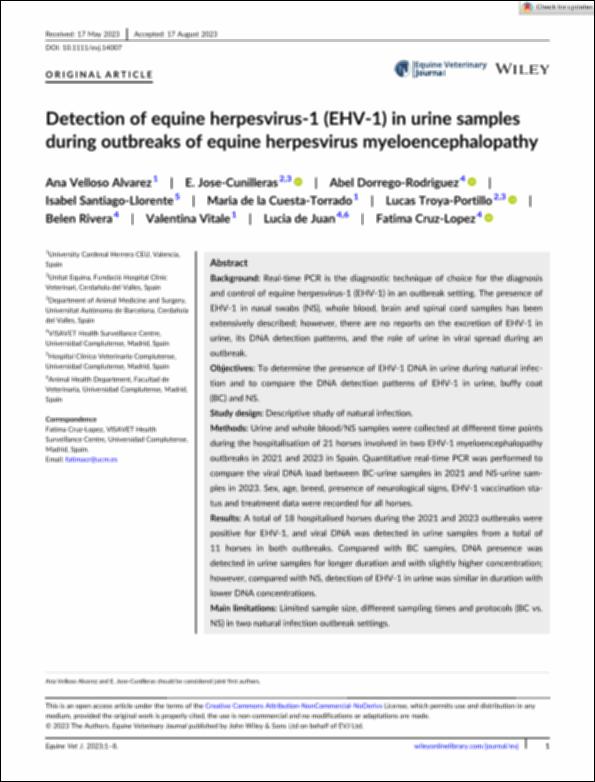Por favor, use este identificador para citar o enlazar este ítem:
http://hdl.handle.net/10637/15110Detection of equine herpesvirus-1 (EHV-1) in urine samplesduring outbreaks of equine herpesvirus myeloencephalopathy
| Título : | Detection of equine herpesvirus-1 (EHV-1) in urine samplesduring outbreaks of equine herpesvirus myeloencephalopathy |
| Autor : | Velloso Álvarez, Ana José Cunilleras, E. Dorrego Rodríguez, Abel Santiago Llorente, Isabel Cuesta Torrado, María de la Troya Portillo, Lucas Rivera, Belén Vitale, Valentina Juan, Lucia de Cruz López, Fátima |
| Materias: | Caballos; Horses; Veterinaria; Veterinary medicine; Medicina preventiva; Preventive medicine; Enfermedad transmisible; Infectious diseases; Aparato respiratorio; Respiratory systems |
| Editorial : | John Wiley & Sons |
| Citación : | Velloso Alvarez, A., Jose-Cunilleras, E., Dorrego-Rodriguez, A., Santiago-Llorente, I., de la Cuesta-Torrado, M., Troya-Portillo, L., Rivera, B., Vitale, V., de Juan, L. & Cruz-Lopez, F. (2023). Detection of equine herpesvirus-1 (EHV-1) in urine samples during outbreaks of equine herpesvirus myeloencephalopathy. Equine Veterinary Journal, Online ahead of print (12 sep.). DOI: https://doi.org/10.1111/evj.14007 |
| Resumen : | Background: Real-time PCR is the diagnostic technique of choice for the diagnosis and control of equine herpesvirus-1 (EHV-1) in an outbreak setting. The presence of EHV-1 in nasal swabs (NS), whole blood, brain and spinal cord samples has been extensively described; however, there are no reports on the excretion of EHV-1 in urine, its DNA detection patterns, and the role of urine in viral spread during an outbreak. Objectives: To determine the presence of EHV-1 DNA in urine during natural infection and to compare the DNA detection patterns of EHV-1 in urine, buffy coat (BC) and NS. Study design: Descriptive study of natural infection. Methods: Urine and whole blood/NS samples were collected at different time points during the hospitalisation of 21 horses involved in two EHV-1 myeloencephalopathy outbreaks in 2021 and 2023 in Spain. Quantitative real-time PCR was performed to compare the viral DNA load between BC-urine samples in 2021 and NS-urine samples in 2023. Sex, age, breed, presence of neurological signs, EHV-1 vaccination status and treatment data were recorded for all horses. Results: A total of 18 hospitalised horses during the 2021 and 2023 outbreaks were positive for EHV-1, and viral DNA was detected in urine samples from a total of 11 horses in both outbreaks. Compared with BC samples, DNA presence was detected in urine samples for longer duration and with slightly higher concentration; however, compared with NS, detection of EHV-1 in urine was similar in duration with lower DNA concentrations. Main limitations: Limited sample size, different sampling times and protocols (BC vs. NS) in two natural infection outbreak settings. Conclusions: EHV-1 was detected in the urine from naturally infected horses. Urine should be considered as complimentary to blood and NS in diagnosis of EHV-1 infection. |
| URI : | http://hdl.handle.net/10637/15110 |
| Derechos: | Open Access http://creativecommons.org/licenses/by-nc-nd/4.0/deed.es |
| ISSN : | 0425-1644 2042-3306 (Electrónico) |
| Fecha de publicación : | 12-sep-2023 |
| Centro : | Universidad Cardenal Herrera-CEU |
| Aparece en las colecciones: | Dpto. Medicina y Cirugía Animal |
Los ítems de DSpace están protegidos por copyright, con todos los derechos reservados, a menos que se indique lo contrario.


